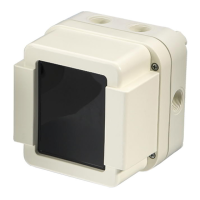2 Structure and function
2.1 Overview
The linear smoke detector FDL241‑9 detects fires according to the principle of light
attenuation by smoke. The linear smoke detector works together with a reflector,
which is installed opposite the detector.
Properties
● Communication via FDnet/C-NET detector line or collective detector line
● Signal processing with ASAtechnology (ASA = Advanced Signal Analysis)
● Detection distance 5…100m
1
● Three sensitivity levels
1
The detection distance of 10…100m meets the requirements of standard
EN54‑12.
In accordance with EN62471, 'Photobiological Safety of Lamps and Lamp
Systems', the linear smoke detector falls into the 'Exempt Group'.
2.2 Function
The linear smoke detector smoke detector consists of a transmitter and a receiver
and works according to the principle of light attenuation by smoke. The transmitter
transmits to the reflector a highly focused, pulse-shaped infrared ray. If no smoke
is present, a large part of the infrared ray reaches the reflector and is returned to
the receiver. The incoming light generates an electric signal on the receiver's photo
diode.
Figure 1: Function of the linear smoke detector without smoke
1 Detector E Receiver
2 Reflector S Transmitter
3 Measuring section 5…100m
1
1
The detection distance of 10…100m meets the requirements of standard
EN54‑12.
Structure and function
Overview
2
6 | 44 A6V10332811_e_en_--

